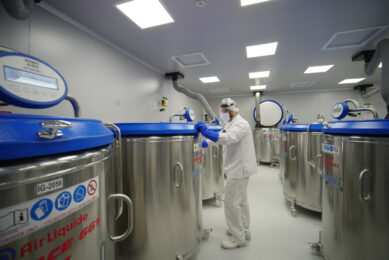How Big Data can help better pig health

Soon, every farm worker will embrace biosecurity, vaccination protocols will be flawless and lung health problems will be picked up much sooner. Sensors and big data are flowing into pig health – and this is only the beginning, writes Pig Progress editor Vincent ter Beek.
What do swine health and Big Data have in common? More than one would think! At the recent European Symposium on Porcine Health Management (ESPHM), held in Barcelona, Spain, 9-11 May, at least 5 different commercial examples were demonstrated where pig health can be supported by Big Data.
Cough monitoring going big
Cough monitoring, an approach using microphones, algorithms and clever warning systems, has been in the market for more than a decade. The Belgian company Soundtalks developed this approach. Together with animal health giant Boehringer Ingelheim, now large-scale trials are being performed in US swine farms, meaning another step in the application’s development, as was described by Boehringer’s Dr Dale Polson at ESPHM.
The idea behind the project was to evaluate the optimal placement and configuration of a continuous sound monitoring system in large airspace buildings – or in other words, if you want to get a correct cough detection with as few microphones as possible, where to hang them in a barn?
Increasing the awareness of biosecurity
MSD Animal Health spoke of B-eSecure, an electronic system that tracks and reports the external and internal biosecurity, which essentially helps swine farmers to change their behaviour. On behalf of MSD, Victor Geurts introduced both components of the plan, being ‘Be Seen Be Safe’ for external biosecurity (see also this article: Mapping the spread of pig disease in real-time) and PRRSoNS for internal biosecurity.

In the latter system, movements of people wearing personalised beacons are followed. Trials on farms in the Netherlands have shown that it helps farms improve their biosecurity and it is an interesting tool for training, instructing and monitoring new employees.
New pig vaccination devices
The year 2018 is definitely the year of the breakthrough of the high-tech vaccination devices. The idea is as follows – place a vial into a holder, hold the shooting part to the pig’s skin and the animal gets injected.
The high-tech part is that the device can store the number of shots and can give a warning when a shot didn’t go well. Using WiFi or Bluetooth, it report back to an app on a smartphone and/or to the farm manager in the office how much was vaccinated to which type of animals, when it happened, and by whom. All presented in easy-to-understand graphs.
Of course it depends on the country whether a pig vet or a skilled stockperson can use it.
Ceva Animal Health: Smartvac
At least 3 major swine health companies now have developed and launched an approach like this. Ceva Animal Health showcased its Smartvac, a system developed in-house. The system has a intramuscular approach, which comes with a needle. In addition, it comes with a ring which needs to be held and pressed in the other hand to perform an injection – a safety and precision feature. At the request of many customers, the company made the concept usable for vaccine vials from other companies.

Interestingly, Ceva also offers lung scoring analysis post-mortem. The results of that can be correlated to the original vaccination schemes and analysed for process optimisation. The device can also record vaccination speed, number of needles used and the productivity.
Hipra: Hipradermic & HipraQnect
Intramuscular vaccination by means of a needle is a feature that can also be found at Hipra’s medical device range – the company offers 2 options. The company offers Hipradermic, an intradermal, needle-free vaccination device, which is exclusively for its PRRS vaccine. The needle-free option is already the 2nd generation and is available in markets where PRRS is a health problem.

All Hipra’s other vaccines can be administered using the new intramuscular device, HipraQnect. The complementary device was announced at ESPHM – and will be introduced gradually now. The main features of the new device are: its quality sensors, to detect the quality of the performance of the vaccination by needle, and its connectivity. HipraQnect, incorporates a 3G SIM card able to transfer all the information recorded directly to the cloud, like a mobile phone. Both devices have been developed by Hipra’s own technological team.
MSD Animal Health: IDAL
Lastly, the company with the longest experience in this field, is Merck/MSD Animal Health with the IDAL. Just before ESPHM, the company introduced its 3rd generation of the device. MSD opted for an exclusive approach – only the company’s vaccines can be used in their IDAL, being Porcilis PCV ID, Porcilis M hyo ID Once, Porcilis PRRS, Porcilis AD Begonia and Prime Pac PRRS.

For the construction of IDAL, MSD has teamed up with well-known quality syringe producer Henke-Sass Wolff from Germany. The 3G has a long-lasting Li-Ion battery, which is twice the service interval of its predecessor. The device also has a new balanced design, ergonomically shaped 2-component surface for maximum grip, and intuitive handling with 2-button control and graphical display.











